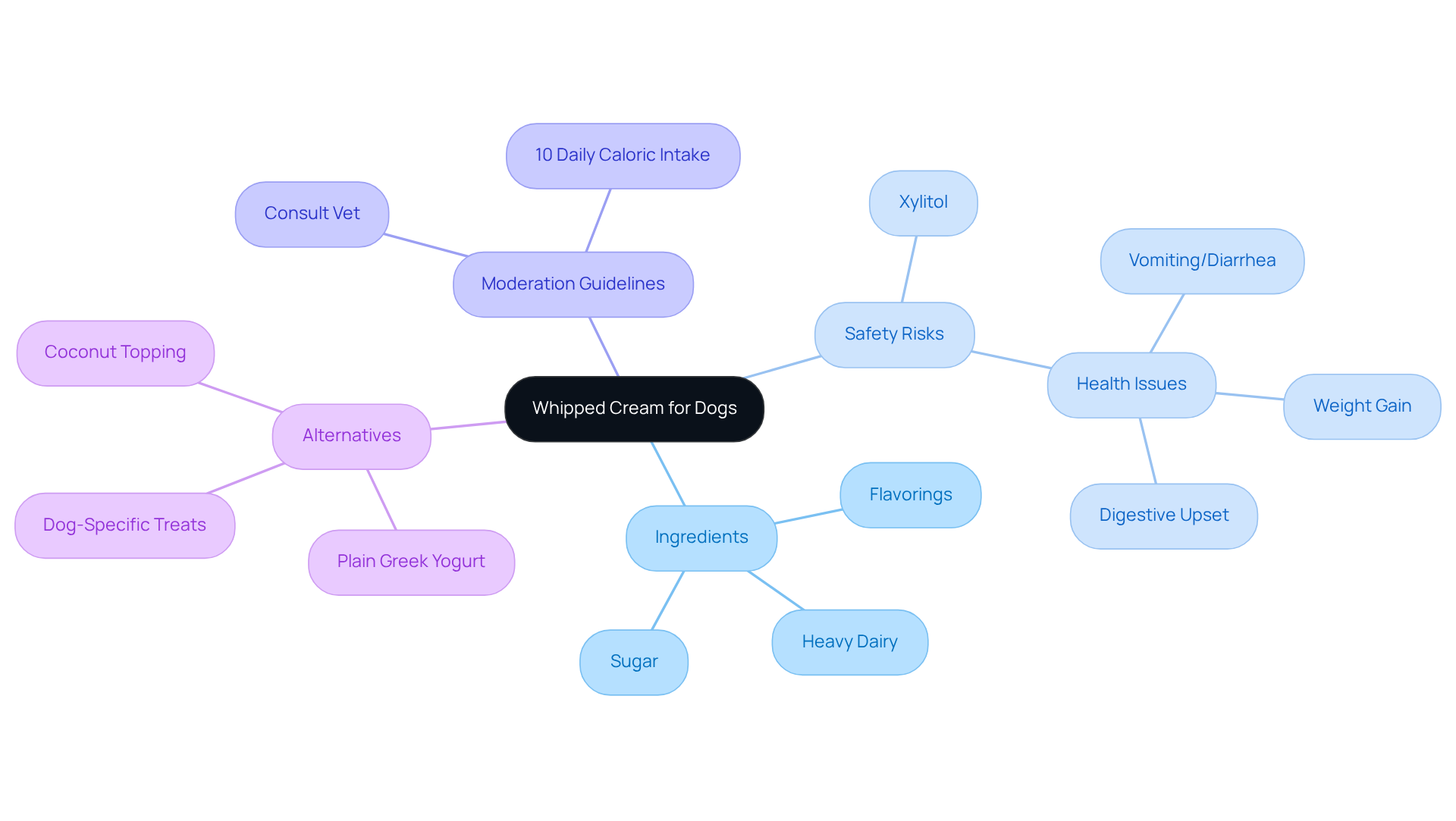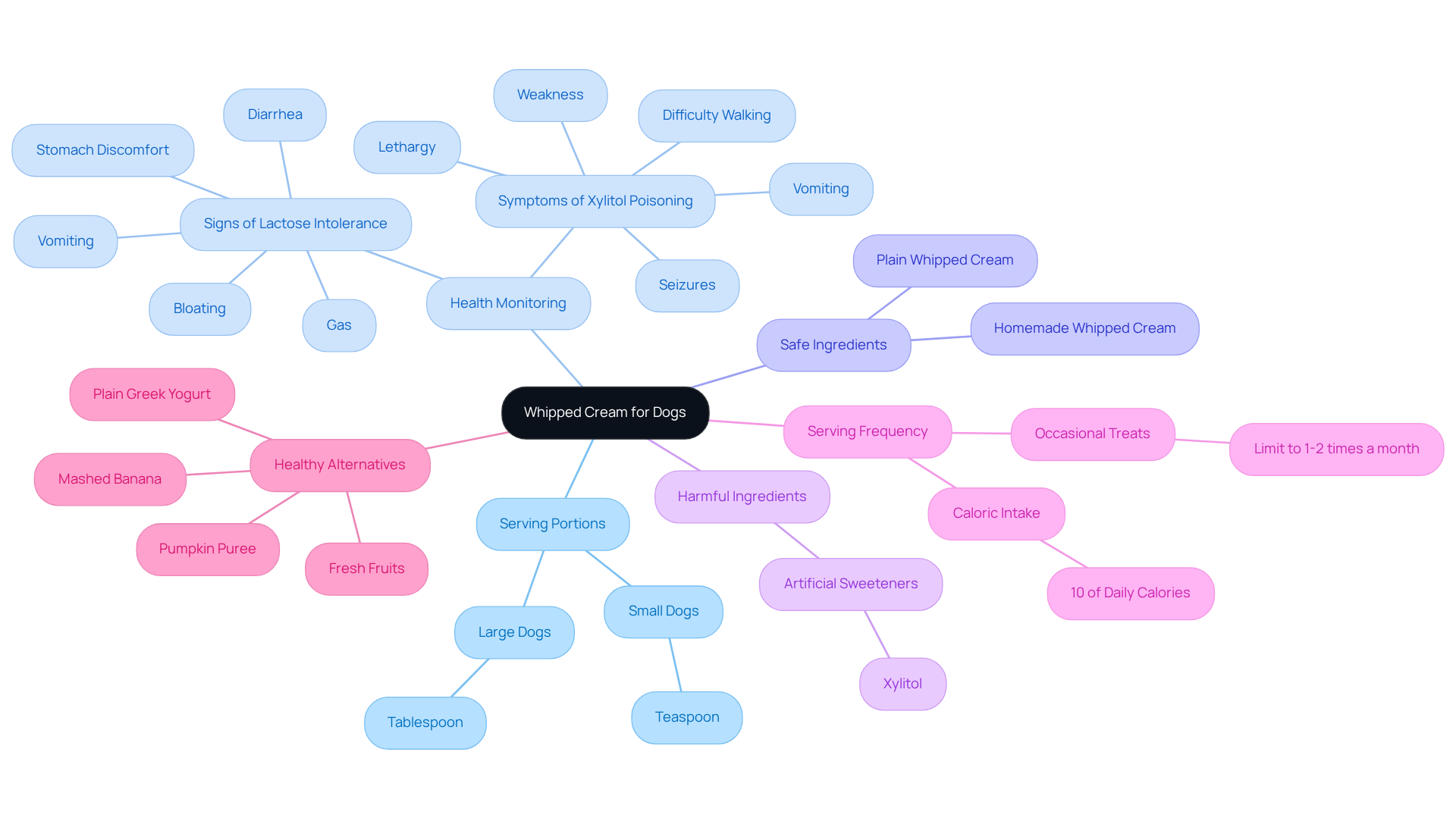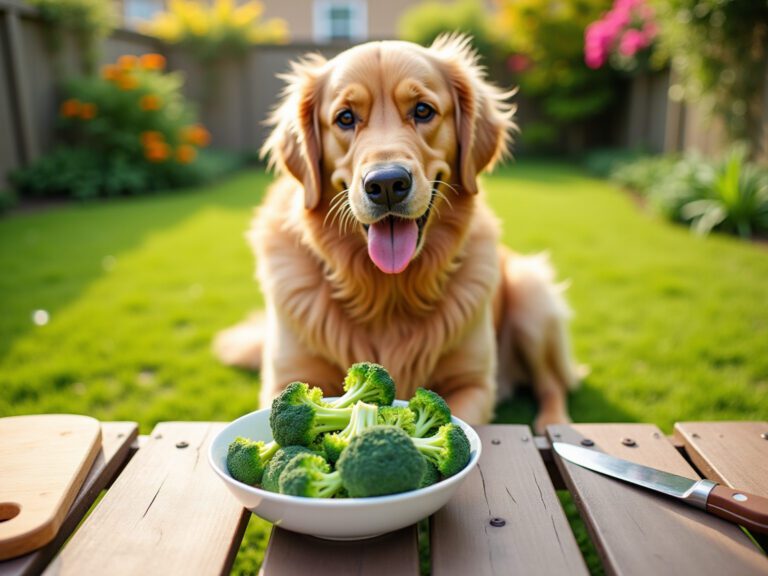Can Dogs Eat Whipped Cream? Safe Serving Tips and Risks
Overview
As a loving pet owner, you may wonder if your furry family members can enjoy whipped cream. The good news is that dogs can indulge in this treat in moderation. However, it’s essential to be cautious about the ingredients and potential health risks involved. Many dogs experience lactose intolerance, and certain additives, like xylitol, can be harmful.
To keep your pup safe, consider the following:
- Serve plain whipped cream in small amounts.
- Always monitor for any adverse reactions, as each dog is unique.
- Consulting with a veterinarian is a wise step to ensure your dog’s well-being.
By taking these precautions, you can create a nurturing environment where your pet can enjoy occasional treats without worry.
Remember, your furry friend’s health is paramount, and with careful consideration, you can make informed choices that enhance their happiness and safety.
Introduction
As a loving pet owner, you may often find yourself contemplating the safety of sharing human treats with your furry family members. One treat that frequently raises concerns is whipped cream, known for its creamy texture and sweet flavor. In this article, we will explore the nuances of whether dogs can safely enjoy whipped cream. We will delve into its ingredients, potential health risks, and best serving practices. With various factors to consider, such as lactose intolerance and harmful additives, how can you ensure that this delightful topping remains a safe indulgence for your beloved pets?
Understand Whipped Cream: Ingredients and Safety for Dogs
Whipped topping, often made from heavy dairy, sugar, and sometimes flavorings like vanilla, leads many pet owners to wonder, can dogs eat whipped cream? While the basic ingredients are not harmful to dogs, it’s essential to check that the aerated topping doesn’t contain dangerous additives, such as xylitol—an artificial sweetener that is highly toxic to dogs and can cause serious health issues or even death in large amounts. Always take a moment to read the label for any additional ingredients that might pose risks, and whenever possible, choose plain aerated topping without added sugars or flavorings.
Moderation is key, as aerated topping tends to be high in fat and sugar, which can lead to health problems if consumed in excess. Some dogs may experience vomiting, diarrhea, or gas after having aerated topping, so it’s wise to keep an eye on your furry family member for 24 hours after introducing it. Consulting with a veterinarian before adding new foods, including dairy toppings, can help ensure your pet’s safety and well-being.
For those with lactose-intolerant canines, coconut aerated topping can be a safe and delightful alternative. Remember, while whipped cream may seem like a fun treat, it’s important to consider whether can dogs eat whipped cream, as it’s not the best choice for them due to potential risks. It should not exceed 10% of your pet’s daily caloric intake. As Veterinary Pathologist Doctor Rick Last noted, ‘Most canines will show some level of adverse reaction after consuming a dairy-based product.’ By being mindful of what you share with your beloved pets, you contribute to their health and happiness.

Evaluate Health Risks: Lactose Intolerance and Sugar Content
Lactose intolerance is a common concern among our beloved canines, affecting a significant portion of the pet population. Estimates suggest that around 50% to 80% of dogs may struggle with lactose intolerance. Many dogs lack the enzyme needed to digest lactose, the sugar found in dairy products, which can lead to discomfort. When considering whether can dogs eat whipped cream, it’s important to note that consuming frothy toppings can result in unpleasant symptoms such as diarrhea, gas, and bloating for these furry family members.
Moreover, aerated toppings are often high in sugar, posing additional health risks. Regular intake can contribute to obesity, dental issues, and other metabolic challenges. It’s also important to note that sugar-free toppings can be dangerous due to the risk of xylitol toxicity, which is harmful to dogs. Given these considerations, it’s essential for pet owners to monitor their pets’ reactions when determining if can dogs eat whipped cream as a creamy topping in their diets.
If you notice any adverse effects, such as vomiting or excessive gas, reaching out to a veterinarian is highly recommended to ensure the well-being of your furry friend. Additionally, for canines with a history of pancreatitis, it’s best to avoid aerated dairy altogether, as it can trigger inflammation in the pancreas. At Adventure Den, we understand how much you care for your pets, and we are here to support you in making the best choices for their health.

Introduce Whipped Cream: Safe Serving Practices and Portions
When considering if dogs can eat whipped cream, it’s important to introduce this fluffy topping to your furry family members with a small quantity—about a teaspoon for smaller pets and a tablespoon for larger breeds. It’s important to monitor your dog’s response for any signs of discomfort or digestive issues, such as diarrhea, vomiting, gas, bloating, or stomach discomfort, which may indicate lactose intolerance. If your dog enjoys it without any issues, consider offering fluffy topping as an occasional treat, limiting it to no more than once or twice a month.
When considering if dogs can eat whipped cream, always serve plain whipped topping and avoid flavored varieties that might contain harmful ingredients like artificial sweeteners, especially xylitol, which is toxic to dogs. Symptoms of xylitol poisoning can include vomiting, weakness, difficulty walking, lethargy, and seizures. Whipped topping can also be a delightful addition to dog-friendly snacks or a rewarding treat during training sessions, leading to the question, can dogs eat whipped cream? Remember, treats should not exceed 10% of your dog’s daily caloric intake; for a 20-pound dog, that means keeping reward calories between 32 to 40.
For a healthier alternative to aerated topping, consider options like plain Greek yogurt, pumpkin puree, or mashed banana, which offer greater nutritional benefits. By practicing portion control and being mindful of your dog’s dietary needs, you can safely incorporate airy toppings into their treat selection, creating a nurturing environment for your beloved pet.

Troubleshoot: Recognizing Reactions and Adjusting Treats
When introducing aerated topping into your dog’s diet, it’s important to be attentive to any negative reactions, such as vomiting, diarrhea, or excessive gas. If your furry family member experiences any of these symptoms, please stop feeding whipped cream immediately and consult your veterinarian to find out if can dogs eat whipped cream. Keeping a detailed log of all snacks consumed can help identify potential triggers for adverse reactions.
Did you know that around 10% of all allergic conditions in dogs are linked to food? This statistic underscores the necessity of being cautious when introducing new snacks. Remember, treats should make up no more than 10% of your dog’s daily caloric intake to ensure a balanced diet.
If your dog struggles with fluffy toppings, consider healthier alternatives like plain yogurt or homemade dog-friendly snacks, which are often gentler on their digestive systems. It’s also crucial to be aware of the high fat and sugar content in whipped cream when asking, can dogs eat whipped cream, as these can pose risks, including potential pancreatitis.
Regular veterinary check-ups can be invaluable in identifying food allergies. Veterinarians recommend closely monitoring your dog’s reactions to new treats. By taking a proactive approach, you can help ensure that any dietary changes contribute positively to your dog’s health and well-being, creating a nurturing environment for your beloved pet.

Conclusion
Whipped cream can be a tempting treat for your furry family members, but it’s essential to approach this indulgence with caution. While the basic ingredients may not pose harm, the potential risks associated with additives, sugar content, and lactose intolerance must not be overlooked. Understanding these factors is vital for ensuring the health and safety of your beloved companions.
Key insights from this article highlight the importance of:
- Moderation and careful ingredient selection when considering whipped cream for dogs.
- Lactose intolerance affects a significant number of dogs, and high sugar content can lead to obesity and other health issues.
- The presence of toxic ingredients like xylitol in some whipped toppings poses a serious risk.
By introducing whipped cream gradually and monitoring for any adverse reactions, pet owners can make informed decisions about their dog’s diet.
Ultimately, prioritizing your dog’s health means being vigilant about what treats are offered. Exploring healthier alternatives, such as plain yogurt or dog-friendly snacks, can provide a safer and more nutritious option. By staying informed and proactive, pet owners can ensure their cherished dogs enjoy treats that contribute positively to their overall well-being.
Frequently Asked Questions
Can dogs eat whipped cream?
While the basic ingredients of whipped cream are not harmful to dogs, it is essential to ensure that it does not contain dangerous additives like xylitol, which is highly toxic to dogs.
What should I check on the label before giving my dog whipped cream?
Always read the label for any additional ingredients that might pose risks, particularly harmful additives such as xylitol. It’s best to choose plain aerated topping without added sugars or flavorings.
Is moderation important when giving whipped cream to dogs?
Yes, moderation is key because whipped cream is high in fat and sugar, which can lead to health problems if consumed in excess.
What should I watch for after my dog consumes whipped cream?
Keep an eye on your dog for 24 hours after introducing whipped cream, as some dogs may experience vomiting, diarrhea, or gas.
Can I give whipped cream to a lactose-intolerant dog?
For lactose-intolerant dogs, coconut aerated topping can be a safe and enjoyable alternative to dairy-based whipped cream.
How much whipped cream can I give my dog?
Whipped cream should not exceed 10% of your pet’s daily caloric intake to avoid potential health issues.
Should I consult a veterinarian before giving my dog whipped cream?
Yes, consulting with a veterinarian before adding new foods, including dairy toppings, is advisable to ensure your pet’s safety and well-being.







